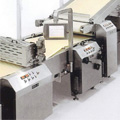Lecithin and it’s applications
For the food formulator looking for a versatile, multifunctional ingredient, look no further than lecithin. In bakery applications, lecithin is used as an emulsifier to ensure even blending, to increase moisture retention, and to improve the release characteristics of bakery products. In addition, its ability to blend dissimilar ingredients evenly and thoroughly helps improve the functionality of all your bakery products.
Reduced-Fat Baked Goods
With the growing trend toward reduced-fat bakery products, food formulators are faced with a new challenge: creating lowfat baked goods that retain the favorable characteristics of their full-fat equivalents. One way to meet the challenge is by using an ingredient that can help restore many of these desired properties—lecithin.
Problems Caused by Fat Removal
- Lowered lubricity, due primarily to the decreased availability of the fat throughout the mix
- Doughs that are hard to machine because they stick to the equipment
- Moisture migration that leaves baked products with a dry texture and mouthfeel
- Poor aeration and weakened cell structure
Breads
Lecithin is used in breads to help achieve greater loaf volumes and increase shelf life. Research has shown it to be most effective in this area in conjunction with other emulsifiers, such as monoglycerides and SSL.
Lecithin is used in pan release applications to help release the bread from the cooking surface. It can also allow for the use of a broader range of flours. Lecithin improves the sheeting properties in yeast raised baked goods. Recommended inclusion rates range from 0.2-0.7% based on flour weight.
Cookies and Crackers
Lecithin is used in cookie applications to improve mixing of the ingredients, improve moisture retention, improve fat-sparing properties, and also to act as an internal release in rotary die cookies. In cracker applications lecithin is used to improve mixing, and decrease the stickiness of the dough, thereby improving dough handling and machining properties. It can also be used in conjunction with oil in top dressing applications. Lecithin will help with the dispersion of spices in top dressing oils. Recommended usage level is 0.2- 0.5% based on flour weight.
Cakes & Doughnuts
In cake formulations it helps improve volume, crumb, and freshness. Recommended usage level is 1-3% based on shortening. In similar application, lecithin is an integral part of cake doughnut mixes. Without lecithin the doughnuts do not achieve the proper amount of fat absorption, leaving them dry and unsavory. In such a state it is also difficult for sugar to adhere to the doughnut. Lecithin is normally part of an emulsifier system also consisting of monoglycerides and PGME.
Icings & fillings
In icing applications lecithin helps impart smoother texture and to prevent drying. Use of lecithin has also been noticed to increase “creaminess” and stiffness of the icing. Usage level would be 0.2-1.0% based on total formula.
Pizza and Piecrusts
Lecithin acts as a natural release agent and significantly reduces dough stickiness, which makes the dough easier to process and saves time.
Tortilla & Flat Breads
Lecithin will help tortillas and flat breads stay flexible and rollable without breaking when folded and be soft without sticking together. ultrafiltered deoiled lecithin is excellent in reduced fat and flavor sensitive applications. Usage level would be 0.5% based on total formula.
Ref: ADM Specialty Products
This post is also available in: Persian







 English
English فارسی
فارسی
Leave a Reply
Want to join the discussion?Feel free to contribute!